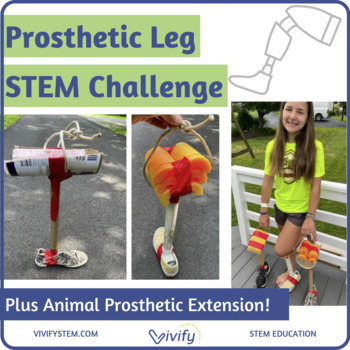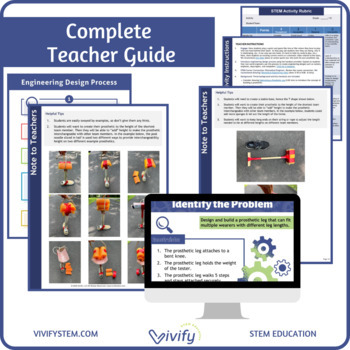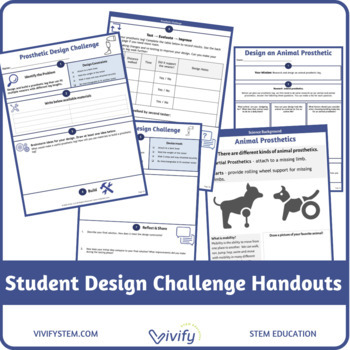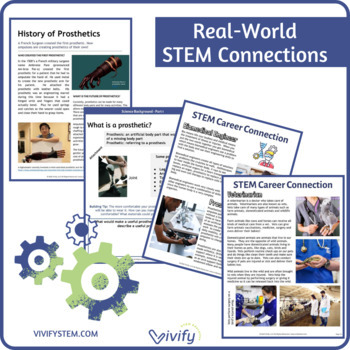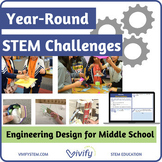Prosthetic Leg Engineering Design STEM Challenge
- PDF
What educators are saying
Also included in
- Are you in need of year-round STEM activities? This growing bundle includes our most popular STEM lessons and engineering design challenges for middle school grades! Click here for more guidance on planning out a STEM class including a scope and sequence and example STEM curriculum map. Includes a SPrice $388.52Original Price $485.65Save $97.13
- Are you in need of year-round STEM activities? This growing bundle includes our most popular STEM lessons and engineering design challenges for elementary! Activities are adaptable for 1st through 5th grade with guidance provided in the teacher notes. Need help with a STEM Curriculum Map? Grab our FPrice $410.72Original Price $513.40Save $102.68
- Are you in need of year-round STEM activities? This growing bundle includes ALL Vivify K-12 STEM lessons from team challenges, engineering design, semester-long STEM units, research projects, and more! Purchase everything for 20% off individual products! Here is a sample of what is included: Stage 1Price $990.24Original Price $1237.80Save $247.56
Description
Prosthetic Design STEM Challenge
After learning the history and uses of prosthetic legs, students use the engineering design process to build a prosthetic leg that is interchangeable for multiple people. This design challenge is followed by a research extension to design a prosthetic leg for an animal.
Lesson Sequence:
- Introduce real-world careers of biomedical engineers and show a video on fabricating a prosthetic leg
- Read about the history of prosthetics
- Learn important concepts related to prosthetics and complete an activity sheet
- Complete the "Who needs a Prosthetic?" activity sheet
- Complete the Prosthetic Leg design challenge in small groups
- Research extension: research and design a prosthetic leg for an animal. Students will research the function and structure of the limbs of the animal chosen and then draw and label a design idea for a prosthetic.
Real-world STEM Connection:
- Biomedical Engineering
- Duck prosthetic leg
- History of prosthetics
- Real-world application of prosthetics for humans
As with many STEM activities, this challenge can be tailored to students of various skill levels and abilities.
Included in this product:
- Detailed teachers guide with links to resources
- Editable teacher companion presentation slides
- Photos and videos of student examples
- Editable printed & digital student handouts to guide them through the design process
- Videos to motivate and support learning
- Editable Google Slides STEM journal for distance learning
- STEM Career Connections and real-world examples
- Science handouts
- Student recording sheet for each step of the process
Suggested Materials: Many different materials can be used for this challenge. Here are some suggestions that worked well for our students.
- Duct tape, masking tape & hot glue gun with glue sticks
- String, rope or twine
- Thick wooden dowels, 1 x 2 wood pieces, broomstick handles, cardboard tubes, plastic pipes
- Strong cardboard & regular cardboard
- Sponges, pool noodles, bubble wrap & old cloth pieces
- Velcro and brass fasteners
- Screwdriver (to punch holes in cardboard)
- Scissors or a small handheld saw
Looking for more STEM lessons? Our team of engineers and educators is dedicated to developing low-prep and high-quality STEM activities for any classroom! Click below to learn more:
- Vivify's Scope & Sequence + Standards Alignment
- Vivify's Resource Guide
- Learn about the 3 Stages of STEM
- Vivify STEM Membership
Customer Tips:
• Click the Green ★ to follow our store and get notifications of new products and freebies
• Leave feedback to receive TpT credit for use on future purchases
• Questions? Contact us in the Product Q&A section
♥ Connect With Us ♥
Email us: info@vivifystem.com

